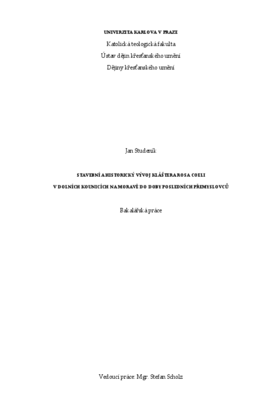Stavební a historický vývoj kláštera Rosa Coeli v Dolních Kounicích na Moravě do doby posledních Přemyslovců
Constructional and Historical Development of the Rosa Coeli Monastrery Ruins at Dolni Kounice in Moravia, until the Era of the Last Přemyslids
bachelor thesis (DEFENDED)

View/
Permanent link
http://hdl.handle.net/20.500.11956/16450Identifiers
Study Information System: 14994
Collections
- Kvalifikační práce [2276]
Author
Advisor
Referee
Kuthan, Jiří
Faculty / Institute
Catholic Theological Faculty
Discipline
History of Christian Arts
Department
Institute of Christian Art History
Date of defense
6. 6. 2008
Publisher
Univerzita Karlova, Katolická teologická fakultaLanguage
Czech
Grade
Excellent
NÁZEV PRÁCE: Stavební a historický vývoj kláštera Rosa coeli v Dolních Kounicích na Moravě do doby posledních Přemyslovců. RESUMÉ: První kapitola shrnuje dosavadní historiografii a badatelské zkoumání kláštera. Druhá kapitola se zabývá stručným vývojem města Dolních Kounic, přírodními podmínkami a kolonizací kraje. Třetí kapitola se zabývá otázkou vzniku konventu, osobou zakladatele, jeho rodiny a předků. Čtvrtá kapitola popisuje a vyhodnocuje úseky dochovaného románského zdiva. Pátá kapitola podává přibližnou rekonstrukci rané podoby kláštera a možnosti další práce na tématu. Šestá a sedmá kapitola shromažďuje písemné a obrazové prameny.
NAME OF WORK: Constructional and historical development of the Rosa coeli monastery in Dolni Kounice in Moravia, until the era of the last Premyslovec. SUMMARY: The first chapter resumes the existing historiography and scholarly research of this monastery. The second chapter offers a concise development of the city of Dolni Kounice, the natural environment and colonization of this area. The third chapter treats of the origin of the convent, the person of the founder, his family and ancestors. The fourth chapter describes and evaluates parts of the preserved Romanesque walls. The fifth chapter offers the approximate reconstruction of the early shape of the monastery and possibilities of further work on this theme. The sixth and seventh chapters bring together the written and pictorial.
